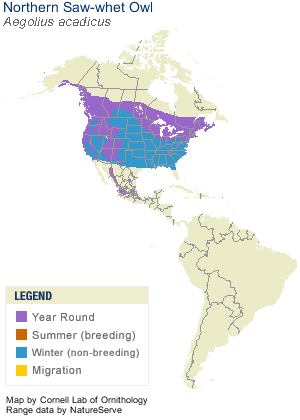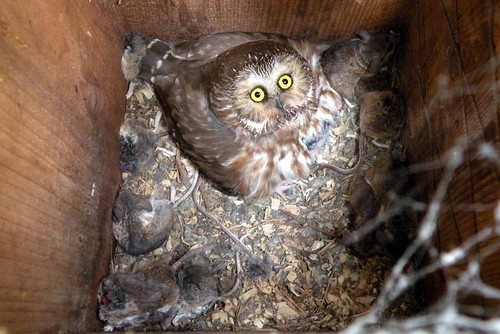The Northern Saw-whet Owl. This hatch year female was banded on September 25, 2015 in Nanaimo, BC. Photo credit: Caitlin Smith
The northern saw-whet owl, Aegolius acadicus, from the family Strigidae, is a small nocturnal forest-dwelling bird that may have been named for having a call that sounds like a saw being sharpened on a whetting stone (Rasmussen, Sealy & Cannings 2008). Their song is a sharp, high too-too-too that is repeated at the same pitch and tempo (Sibley 2003). This song can be heard in dense forests from January to May, as it plays a role in male establishment of a roost spot and attracting a mate (Rasmussen, Sealy & Cannings, 2008). The following video is a recording of this sound. They also make a shrill cat-like call and various other sounds involved in mating, alarming and nesting behavior (Rasmussen, Sealy & Cannings 2008).
Adult saw-whet owls are only about eight inches tall, have a wingspan of around 17 inches and weigh around 80 grams, with females being noticeably larger than males. They are fluffy mottled brown birds with a large round white-spotted head which lacks ear tufts and have yellow eyes and a distinct white V-shape on their face (Sibley 2003). They live in forests across Southern Canada and throughout the United States, with populations extending as far north as Alaska and as far south as Mexico. Breeding occurs throughout its range and some populations winter in the central and southern United States (Sibley 2003).

Geographical distribution of the Northern Saw-whet Owl (Aegolius acadicus). Source
Due to their strictly nocturnal and elusive behavior, migration in this species was not very well understood in the past, but in the 1990s a collaboration called Project Owlnet allowed 100 saw-whet migration banding sites to be established by attracting owls to mist nets using their too-too-too call (Rasmussen, Sealy & Cannings 2008). These owls can migrate long distances and across large bodies of water, like the Great Lakes (Rasmussen, Sealy & Cannings 2008). They prefer dense mature forests, usually near rivers, but can nest in a variety of habitats including deciduous forests, savannahs, coniferous swamps, shrub-steppe habitat and sand dune meadows. They nest in tree cavities, usually in holes that were previously made by woodpecker species, especially those of the Northern Flicker (Colaptes auratus). They cover the bottom with twigs, leaves, moss, small mammal bones or other kinds of debris (Rasmussen, Sealy & Cannings 2008).
Saw-whet owls usually live between five and seven years and begin breeding in their second year (COSEWIC 2006). Most saw-whets are monogamous, but when there is abundant prey, males may have more than one mate. They lay 4-7 eggs and have 1-2 broods per year and females tend to the nest and incubate the eggs while the males hunt (Rasmussen, Sealy & Cannings 2008). Fledglings have buffy/orange belly with a brown head (see video at end of this post; Sibley 2003).

Female saw-whet owl incubating her eggs in a nest box, and surrounded by dead mice caught by the male. Source
Despite their size and cute appearance, saw-whets have extremely sharp claws and hunt almost all kinds of small mammals like mice, shrews, voles, bats and chipmunks, but their most common prey is deer mice (Peromyscus spp.) (Rasmussen, Sealy & Cannings 2008). During migration they may eat other birds like chickadees, juncos, warblers and even thrushes and other small owls. They may also eat various kinds of insects and coastal owls feed on intertidal crustaceans (Cannings 2004). Saw-whets can be prey for larger owls, hawks, and falcons but they can usually stay well hidden. They hunt during the night and can be very hard to find during the day as they roost in thick conifers and hide themselves well in dense foliage (Rasmussen, Sealy & Cannings 2008).
Ageing northern saw-whet owls can be relatively simple, due to the presence of a molecule called porphyrin in newly grown flight feathers of owls. Porphyrin is related to hemoglobin, and fluoresces a bright magenta colour under ultraviolet (black) light (Weidensaul et al. 2011). The following picture is an example of a saw-whet being aged by this method. Since the magenta colour extends from the coverts to the outer primaries and inner secondaries, it can be determined that this bird is in its second year, as it is beginning to moult its old first year feathers.
This wing shows a second year NSWO that has molted its outer primaries and inner secondaries. Source
The population trends of saw-whet owls are hard to track as they are so secretive and it is difficult to get accurate counts. They have a least concern status with the International Union for Conservation of Nature (IUCN), however the subspecies in Haida Gwaii is threatened (to be discussed in the next blog post!). Their habitat can be threatened by logging and development and climate change impacts may affect the future range of this species (Rasmussen, Sealy & Cannings 2008).
And just for cuteness factor, here’s some baby saw-whet owls!
References
Cannings, R. J. 2004. “Queen Charlotte” Saw-whet Owl. Accounts and Measures for Managing Identified Wildlife. 7 pp.
COSEWIC 2006. COSEWIC assessment and status report on the Northern Saw-whet Owl brooksi subspecies Aegolius acadicus brooksi in Canada. Committee on the Status of Endangered Wildlife in Canada. Ottawa. vi + 23 pp.
Rasmussen, J.L., Sealy, S. G., & Cannings, R. J. 2008. Northern Saw-whet Owl (Aegolius acadicus). The Birds of North America Online, No. 42 (A. Poole, Ed.). Cornell Lab of Ornithology, Ithaca, NY. Retrieved from Cornell Lab of Ornithology, All About Birds: http://bna.birds.cornell.edu/bna/species/042/articles/introduction
Sibley, D. A. 2003. The Sibley Field Guide to Birds of Western North America. Alfred A. Knopf, New York.
Weidensaul, S., Colvin, B. A., Brinker, D. F., & Huy, J. S. 2011. Use of Ultraviolet LIght as an Aid in Age Classification of Owls. The Wilson Journal of Ornithology. 123: 373-377.


Great read! You pointed out some interesting facts… I found the way they age the birds to be especially interesting! Plus the cuteness factor all over this blog was a major plus!
Thanks Amanda! Ya it is pretty cool how they age them, and yes they are just precious, one of my favourite birds.